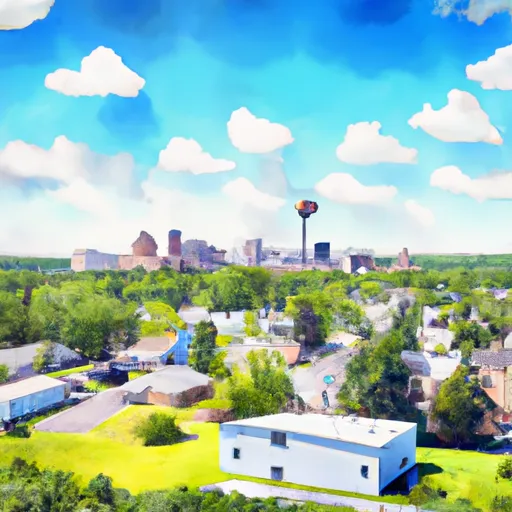-
 Snoflo Premium
Snoflo Premium
Get unlimited access to all our content
With no Ad interruptions! - Start Your Free Trial Login with existing account
Kasson
Eden Index
Climate
6.3
•
Recreation
•
Community
4.9
•
Safeguard
3.7/10

Kasson, Minnesota is a small city located in Dodge County in the southeastern part of the state. The climate in Kasson is classified as continental, with cold winters and warm summers. The average temperature in January, the coldest month, is around 16°F (-9°C), while the average temperature in July, the warmest month, is about 73°F (23°C). Precipitation is evenly distributed throughout the year, with an average annual rainfall of 32 inches (81 cm) and about 50 inches (127 cm) of snowfall.
Hydrology constituents in Kasson include several rivers and creeks that flow through the area, such as the Middle Fork Zumbro River and Pleasant Creek. These water bodies provide opportunities for fishing, canoeing, and kayaking. Kasson also has a few lakes nearby, including Lake Foster and Rice Lake, which offer additional recreational activities like boating and swimming.
Outdoor enthusiasts in Kasson can take advantage of the city's parks and trails. Kasson-Mantorville Park is a popular spot for picnicking, hiking, and playing sports, while the K-M Trail provides a scenic route for walking, running, and biking. Overall, Kasson offers a pleasant climate, diverse hydrology constituents, and several outdoor recreation opportunities for residents and visitors to enjoy.
What is the Eden Index?
The Snoflo Eden Index serves as a comprehensive rating system for regions, evaluating their desirability through a holistic assessment of climate health, outdoor recreation opportunities, and natural disaster risk, acknowledging the profound impact of these factors on livability and well-being.
Climate Health Indicator (CHI): 6.3
Kasson receives approximately
846mm of rain per year,
with humidity levels near 83%
and air temperatures averaging around
7°C.
Kasson has a plant hardyness factor of
4, meaning
plants and agriculture in this region thrive during a short period during spring and early summer. Most
plants will die off during the colder winter months.
By considering the ideal temperature range, reliable water supplies, clean air, and stable seasonal rain or snowpacks, the Climate Health Indicator (CHI) underscores the significance of a healthy climate as the foundation for quality living.
A healthy climate is paramount for ensuring a high quality of life and livability in a region, fostering both physical well-being and environmental harmony. This can be characterized by ideal temperatures, reliable access to water supplies, clean air, and consistent seasonal rain or snowpacks.
Weather Forecast
Streamflow Conditions
Upper Mississippi-Black-Root
Area Rivers
Upper Mississippi-Black-Root
Snowpack Depths
Upper Mississippi-Black-Root
Reservoir Storage Capacity
Upper Mississippi-Black-Root
Groundwater Levels
Recreational Opportunity Index (ROI):
The Recreational Opportunity Index (ROI) recognizes the value of outdoor recreational options, such as parks, hiking trails, camping sites, and fishing spots, while acknowledging that climate plays a pivotal role in ensuring the comfort and consistency of these experiences.
Access to outdoor recreational opportunities, encompassing activities such as parks, hiking, camping, and fishing, is crucial for overall well-being, and the climate plays a pivotal role in enabling and enhancing these experiences, ensuring that individuals can engage in nature-based activities comfortably and consistently.
Camping Areas
| Campground | Campsites | Reservations | Toilets | Showers | Elevation |
|---|---|---|---|---|---|
| Lake Keomah State Park | 65 | 810 ft | |||
| Thousand Hills State Park | None | 862 ft | |||
| Glendale Access | None | 696 ft | |||
| Thomas Hill Reservoir - Hwy T Campground - MDC | 10 | 753 ft | |||
| Eveland Access | 26 | 679 ft | |||
| Quercus Wilderness Area | 5 | 670 ft | |||
| Cedar Creek Access | None | 704 ft | |||
| Union Mills Access | None | 762 ft | |||
| Miami Lake Park | None | 918 ft | |||
| Lake Wapello State Park | 80 | 803 ft |
Nearby Fishing
Nearby Ski Areas
Catastrophe Safeguard Index (CSI):
The Catastrophe Safeguard Index (CSI) recognizes that natural disaster risk, encompassing floods, fires, hurricanes, and tornadoes, can drastically affect safety and the overall appeal of an area.
The level of natural disaster risk in a region significantly affects safety and the overall livability, with climate change amplifying these risks by potentially increasing the frequency and intensity of events like floods, fires, hurricanes, and tornadoes, thereby posing substantial challenges to community resilience and well-being.
Community Resilience Indicator (CRI): 4.9
The Community Resilience Indicator (CRI) recognizes that education, healthcare, and socioeconomics are crucial to the well-being of a region. The CRI acknowledges the profound impact of these elements on residents' overall quality of life. By evaluating educational resources, healthcare accessibility, and economic inclusivity, the index captures the essential aspects that contribute to a thriving community, fostering resident satisfaction, equity, and social cohesion.

